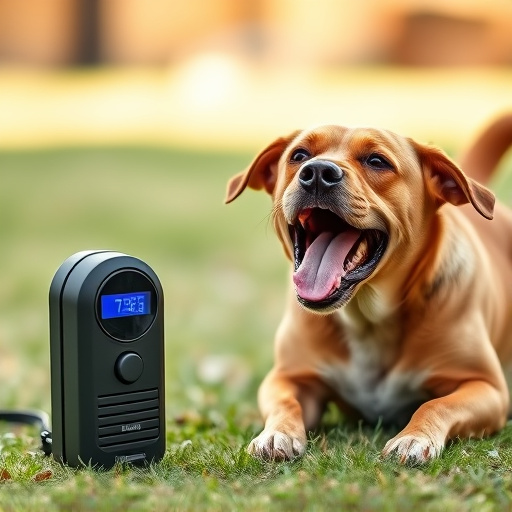Sonic dog training, a modern and humane approach, uses safe ultrasonic frequencies (25-64 kHz) to guide canine behavior. By leveraging dogs' superior hearing, it corrects unwanted actions like barking or jumping without causing harm or fear. At-home devices emit inaudible sounds to capture a dog's attention, promoting positive behaviors through gentle correction and praise. Key steps include choosing the right device, setting frequencies, placing it strategically, timing activation, and using consistent positive reinforcement.
“Explore the revolutionary world of sonic dog training, a humane behavioral correction method that leverages ultrasonic frequencies. This gentle approach offers an alternative to traditional, often harsh, training techniques. Our article delves into the science behind ultrasonic waves and their subtle yet effective impact on canine behavior. We guide you through safe implementation at home, ensuring well-being while teaching your pet new tricks. Discover how to utilize these safe ultrasonic frequencies for dog control, fostering a positive and effective training experience.”
- Understanding Sonic Dog Training: A Gentle Approach to Behavioral Correction
- The Science Behind Ultrasonic Frequencies and Their Effect on Dogs
- Implementing Safe Sonic Dog Training Techniques at Home
Understanding Sonic Dog Training: A Gentle Approach to Behavioral Correction
Sonic dog training, also known as ultrasonic behavioral correction, is a modern approach to canine discipline that utilizes safe ultrasonic frequencies to guide dogs’ behavior. Unlike traditional punishment methods, it focuses on positive reinforcement and gentle guidance rather than fear or discomfort. This innovative technique employs high-frequency sound waves that are inaudible to humans but can capture a dog’s attention, prompting them to alter their actions.
By emitting these safe ultrasonic frequencies, sonic dog training enables owners to communicate with their pets instantly. It is particularly effective during moments of unwanted behavior, such as excessive barking or jumping on guests. The gentle nature of the correction allows dogs to learn and adjust without causing physical harm or creating negative associations, ensuring a harmonious relationship between the owner and their canine companion.
The Science Behind Ultrasonic Frequencies and Their Effect on Dogs
Ultrasonic frequencies, while invisible to human ears, have been found to be highly effective in modifying canine behavior through a process known as sonic dog training. These sounds operate at a higher pitch than what humans can detect, typically ranging from 25 to 64 kHz. Importantly, dogs’ hearing is far more sensitive than ours, allowing them to perceive and respond to these ultrasonic signals. When used for behavioral correction, safe ultrasonic frequencies are targeted towards specific actions, such as excessive barking or jumping, without causing harm or discomfort to the dog. This technology leverages dogs’ natural ability to respond to sounds, training them to associate certain behaviors with an unpleasant yet harmless ultrasonic tone.
The science behind this method suggests that ultrasonic frequencies can disrupt a dog’s focus on the target behavior by creating a slight discomfort or distraction. This disruption, without causing any physical harm, encourages dogs to alter their actions and learn new, desired behaviors. As such, safe ultrasonic frequencies for dog control represent a modern, innovative approach to training that leverages scientific understanding of canine perception.
Implementing Safe Sonic Dog Training Techniques at Home
Implementing safe ultrasonic frequencies for dog training at home is a responsible approach to behavioral correction. These devices emit high-pitched sounds that are inaudible to humans but can capture your dog’s attention, helping them understand desired behaviors. When used correctly, ultrasonic trainers can be highly effective in modifying unwanted actions like excessive barking or jumping on furniture.
Choose a device designed for dogs and set it to an appropriate frequency range. Place the device in areas where problematic behaviors occur, ensuring it operates within safe decibel levels. Timing is crucial; activate the device as soon as you observe the unwanted behavior, rewarding your dog with praise or treats when they cease. Consistency and patience are key; over-reliance on ultrasonic trainers can cause stress or anxiety in some dogs, so balance its use with positive reinforcement techniques for best results.
Sonic dog training offers a modern, non-violent approach to behavioral correction, leveraging safe ultrasonic frequencies that dogs can hear but humans cannot. By understanding the science behind this method and implementing techniques responsibly at home, owners can effectively communicate with their pets while fostering positive reinforcement. Incorporating safe ultrasonic frequencies into your dog’s training regimen allows for a gentle, yet effective, way to navigate behavior challenges, ultimately strengthening the bond between owner and pet.
